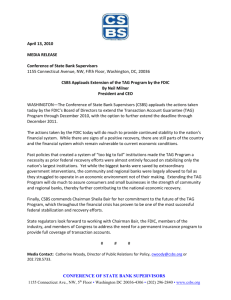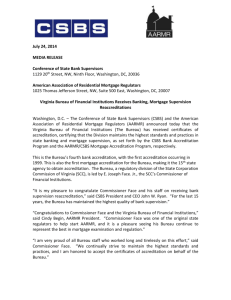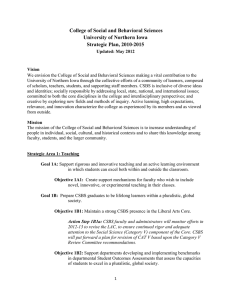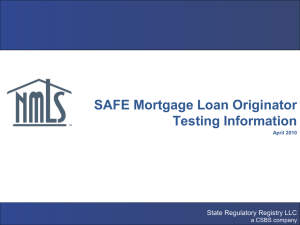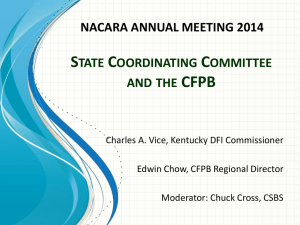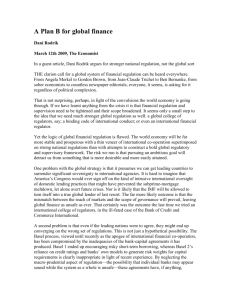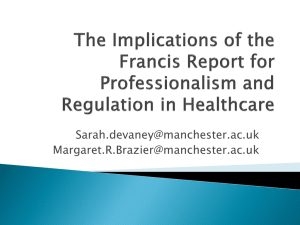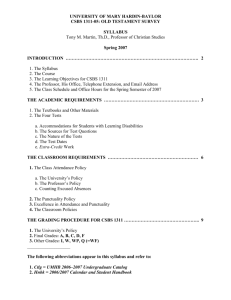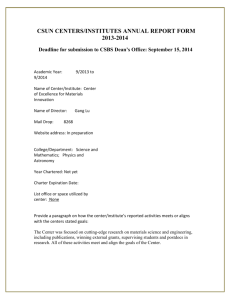CSBS Comment Letter On GAO Regulatory Modernization Study
advertisement
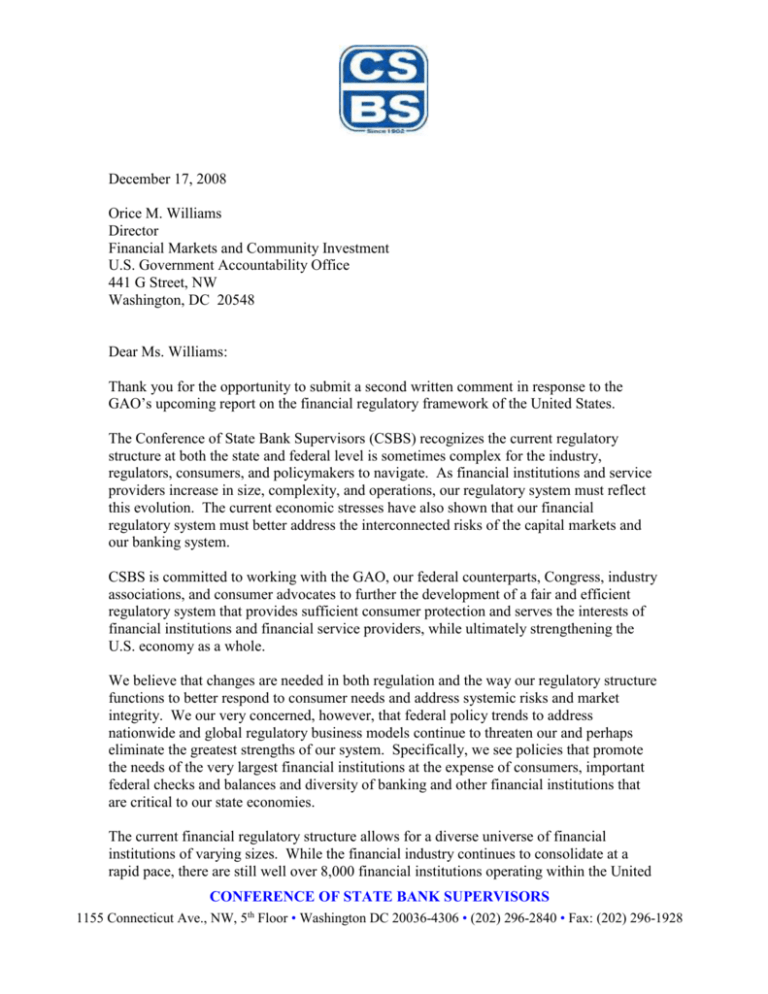
December 17, 2008 Orice M. Williams Director Financial Markets and Community Investment U.S. Government Accountability Office 441 G Street, NW Washington, DC 20548 Dear Ms. Williams: Thank you for the opportunity to submit a second written comment in response to the GAO’s upcoming report on the financial regulatory framework of the United States. The Conference of State Bank Supervisors (CSBS) recognizes the current regulatory structure at both the state and federal level is sometimes complex for the industry, regulators, consumers, and policymakers to navigate. As financial institutions and service providers increase in size, complexity, and operations, our regulatory system must reflect this evolution. The current economic stresses have also shown that our financial regulatory system must better address the interconnected risks of the capital markets and our banking system. CSBS is committed to working with the GAO, our federal counterparts, Congress, industry associations, and consumer advocates to further the development of a fair and efficient regulatory system that provides sufficient consumer protection and serves the interests of financial institutions and financial service providers, while ultimately strengthening the U.S. economy as a whole. We believe that changes are needed in both regulation and the way our regulatory structure functions to better respond to consumer needs and address systemic risks and market integrity. We our very concerned, however, that federal policy trends to address nationwide and global regulatory business models continue to threaten our and perhaps eliminate the greatest strengths of our system. Specifically, we see policies that promote the needs of the very largest financial institutions at the expense of consumers, important federal checks and balances and diversity of banking and other financial institutions that are critical to our state economies. The current financial regulatory structure allows for a diverse universe of financial institutions of varying sizes. While the financial industry continues to consolidate at a rapid pace, there are still well over 8,000 financial institutions operating within the United CONFERENCE OF STATE BANK SUPERVISORS 1155 Connecticut Ave., NW, 5th Floor • Washington DC 20036-4306 • (202) 296-2840 • Fax: (202) 296-1928 States, some of which are as small as $1 million in assets. Obviously, our nation’s largest money center banks play a critical role in the economy. However, even the smallest bank in the country is absolutely critical to the economic health of the community in which it operates. The complexity of the system is presented as a major source of the current financial crisis. While there are clearly gaps in our regulatory system and the system is undeniably complex, CSBS has observed that the greater failing of the system has been one of insufficient political and regulatory will, primarily at the federal level. We believe that decisions to consolidate regulation do not fix, but rather exacerbate this problem. Moreover, CSBS is deeply concerned that the study does not fully appreciate the importance of creating an environment that promotes a diverse industry which serves our nations diverse communities and avoids a concentration of economic and political power in a handful of institutions. Specifically, we are offering the following comments to the specified elements of a successful supervisory framework. Clearly Defined Regulatory Goals Generally, we agree with the GAO’s goals of a regulatory system that ensures adequate consumer protections, ensures the integrity and fairness of markets, monitors the safety and soundness of institutions, and acts to ensure the stability of the overall financial system. We disagree, however, with the GAO’s claim that the safety and soundness goal is necessarily in direct conflict with the goal of consumer protection. It has been the experience of state regulators that the very opposite can be true. Indeed, consumer protection should be recognized as integral to safety and soundness of financial institutions and service providers. The health of a financial institution ultimately is connected to the health of its customers. However, we have observed that federal regulators, without the checks and balances of more locally responsive state regulators or state law enforcement do not always give fair weight to consumer issues or have the perspective to understand consumer issues. We consider this a significant weakness of the current system. Federal preemption of state law and state law enforcement by the Office of the Comptroller of the Currency and the Office of Thrift Supervision has resulted in less responsive consumer protections and institutions that are much less responsive to needs of consumers in our states. Appropriately Comprehensive CSBS disagrees that federal regulators were unable to identify the risks to the financial system because they did not have the necessary scope of oversight. As previously noted, we believe it was a failure of regulatory will and a philosophy of self-regulating markets that allowed for risks to develop. CSBS strongly believes a “comprehensive” system of regulation should not be construed as a consolidated regime under one single regulator. Instead, “comprehensive” should describe a regulatory system that is able to adequately supervise a broad, diverse, and dynamic financial industry. We believe that the checks and balances of the dual system of federal and state supervision are more likely to result in comprehensive and meaningful coverage of the industry. From a safety and soundness perspective and from a consumer protection standpoint, the public is better served by a coordinated regulatory network that benefits from both the federal and state perspectives. We believe the FFIEC could be much better utilized to accomplish this approach. Systemwide Focus The GAO report states “a regulatory system should include a mechanism for identifying, monitoring, and managing risks to the financial system regardless of the source of the risk or the institutions in which it was created.” CSBS agrees with this assessment. Our current crisis has shown us that our regulatory structure was incapable of effectively managing and regulating the nation’s largest institutions. CSBS believes the solution, however, is not to expand the federal government bureaucracy by creating a new super regulator. Instead, we should enhance coordination and cooperation among the federal government and the states. We believe regulators must pool resources and expertise to better manage systemic risk. The Federal Financial Institutions Examination Council (FFIEC) provides a vehicle for working towards this goal of seamless federal and state cooperative supervision. In addition, CSBS provides significant coordination among the states as well as with federal regulators. This coordinating role reached new levels when Congress adopted the Riegle-Neil Act to allow for interstate banking and branching. The states, through CSBS, quickly followed suit by developing the Nationwide Cooperative Agreement and the StateFederal Supervisory Agreement for the supervision of multi-state banks. Most recently, the states launched the Nationwide Mortgage Licensing System (NMLS) and a nationwide protocol for mortgage supervision. Further, the NMLS is the foundation for the recently enacted Secure and Fair Enforcement for Mortgage Licensing Act of 2008, or the S.A.F.E. Act. The S.A.F.E. Act establishes minimum mortgage licensing standards and a coordinated network of state and federal mortgage supervision. Flexible and Adaptable CSBS agrees that a regulatory system should be adaptable and forward-looking so that regulators can readily adapt to market innovations and chances to include a mechanism for evaluating potential new risks to the system. In fact, this is one of the greatest strengths of the state system. The traditional dynamic of the dual-banking system of regulation has been that the states experiment with new products, services, and practices that, upon successful implementation, Congress later enacts on a nationwide basis. In addition, state bank examiners are often the first to identify and address economic problems. Often, states are the first responders to almost any problem in the financial system. The states can—and do—respond to these problems much more quickly than the federal government as evidenced by escalating state responses to the excesses and abuses of mortgage lending over the past decade. Unfortunately, the federal response was to thwart rather than encourage these policy responses. Efficient and Effective In the report, GAO asserts that a system should provide for efficient and effective oversight by eliminating overlapping federal regulatory mission and minimizing regulatory burden. CSBS believes efficiency must not be achieved at the cost of protecting consumers, providing for a competitive industry that serves all communities or maintaining the safety and soundness of financial institutions. We recognize that our regulatory structure is complex and may not be as efficient as some in the industry would prefer. There is undoubtedly a need for improved coordination and cooperation among functional regulators. However, this efficiency must not be met through the haphazard consolidation or destruction of supervisory agencies and authorities. CSBS strongly believes that it is more important to preserve a regulatory framework with checks and balances among and between regulators. This overlap does not need to be a negative characteristic of our system. Instead, it has most often offered additional protection for our consumers and institutions. We believe that the weakening of these overlays in recent years weakened our system and contributed to the current crisis. In addition, we should consider how “efficient” is defined. Efficient does not inherently mean effective. Our ideal regulatory structure should balance what is efficient for large and small institutions as well as what is efficient for consumers and our economy. While a centralized and consolidated regulatory system may look efficient on paper or benefit our largest institutions, the outcomes may be inflexible and be geared solely at the largest banks at the expense of the small community institutions, the consumer or our diverse economy. Consistent Consumer and Investor Protection The states have long been regarded as leaders in the consumer protection arena. This is an area where the model of states acting as laboratories of innovation is clearly working. State authorities often discover troubling practices, trends, or warning signs before the federal agencies can identify these emerging concerns. State authorities and legislature then are able to respond quickly to protect consumers. Ultimately, Congress and federal regulators can then rely on state experience to develop uniform and nationwide standards or best practices. Ultimately, we believe the federal government is simply not able to respond quickly enough to emerging threats and consumer protection issues. State authorities have also been frustrated by federal preemption of state consumer protection laws. If Congress were to act to repeal or more clearly limit these preemptions, states would be able to more effectively and consistently enforce consumer protection laws. CSBS also agrees that there were significant loopholes and unequal regulation and examination of the mortgage industry. In fact, the states led the way to address these regulatory gaps. However, in describing where subprime lending occurred, we believe the report should acknowledge the fact that subprime lending took place in nearly equal parts between nonbank lenders and institutions subject to federally bank regulation. Federal regulation of operating subsidiaries has been inconsistent at best and nonexistent at worst. As acknowledged in the report, affiliate regulation for consumer compliance simply did not exist at the federal level until a recent pilot project led by the Federal Reserve was initiated. The report also fails to acknowledge the very significant reforms of mortgage regulation adopted by Congress under the S.A.F.E. Act or the major efforts the states have engaged in to regulate the nonbank mortgage lenders and originators. Regulators Provided with Independence, Prominence, Authority, and Accountability The dual-banking system helps preserve both regulator independence and accountability. The state system of chartering, with an independent primary federal regulator probably serve as the best model for this goal. Consistent Financial Oversight Consistency in regulation is important, but our financial system must also be flexible enough to allow our diverse institutions all to flourish. The diversity of our nation’s banking system has created the most dynamic and powerful economy in the world, regardless of the current problems we are experiencing. The strength at the core of our banking system is that it is comprised of thousands of financial intuitions of vastly different sizes. Even as our largest banks are struggling to survive, the vast majority of community banks remains strong and continues to provide financial services to their local citizens. It is vital that our a one size fits all regulatory system does not adversely affect the industry by putting smaller banks at a competitive disadvantage with larger, more complex institutions. It is our belief that the report should acknowledge the role of federal preemption of state consumer protections and the lack of responsiveness of federal law and regulation to mortgage lending and consumer protection issues. For example, the states began responding in 1999 to circumventions of HOEPA and consumer abuses related to subprime lending. Nine years later and two years into a nationwide subprime crisis and Congress has yet been able to adopt a predatory lending law. We believe that some industry advocates have pushed for preemption to prevent the states from being able to develop legislative and regulatory models for consumer protection and because they have been successful in thwarting legislation and significant regulation at the federal level. Minimal Taxpayer Exposure CSBS strongly agrees that a regulatory system should have adequate safeguards that allow financial institution failures to occur while limiting taxpayers' exposure to financial risk. Part of this process must be prevent institutions from becoming “too big to fail,” “too systemic to fail,” or simply too big to regulate. Specifically, the federal government must have regulatory tools in place to manage the orderly failure of the largest institutions rather than continuing to prop up failed systemic institutions. CSBS Principles of Regulatory Reform While numerous proposals will be advanced to overhaul the financial regulatory system, CSBS believes the structure of the regulatory system should: 1. Usher in a new era of cooperative federalism, recognizing the rights of states to protect consumers and reaffirming the state role in chartering and supervising financial institutions. 2. Foster supervision that is tailored to the size, scope, and complexity of the institution and the risk they pose to the financial system. 3. Assure the promulgation and enforcement of consumer protection standards that are applicable to both state and nationally chartered financial institutions and are enforceable by locally-responsive state officials against all such institutions. 4. Encourage a diverse universe of financial institutions as a method of reducing risk to the system, encouraging competition, furthering innovation, insuring access to financial markets, and promoting efficient allocation of credit. 5. Support community and regional banks, which provide relationship lending and fuel local economic development. 6. Require financial institutions that are recipients of governmental protection or pose systemic risk to be subject to safety and soundness and consumer protection oversight. The states, through CSBS and the State Liaison Committee’s involvement on the FFIEC, will be part of any solution to regulatory restructuring or our current economic condition. We want to ensure consumers are protected, and preserve the viability of both the federal and state charter to ensure the success of our dual-banking system and our economy as a whole. CSBS believes there is significant work to be done on this issue, and we commend the GAO for undertaking this report. Best regards, John W. Ryan Executive Vice President
